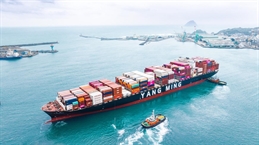
Yang Ming Marine Transport Corp. (Yang Ming) remains cautious yet optimistic about the container shipping market as recent progress in U.S.-China trade talks signals potential demand improvements.
During its 403rd Board Meeting on May 13, Yang Ming reported Q1 revenues of NT$45.51 billion (US$1.38 billion), reflecting stable performance across Europe/Mediterranean, Intra-Asia, Australia, and the Middle East.
However, tariff-driven trade policies led to a decline in China-U.S. cargo volumes in Q2.
Yang Ming also signalled that the broader economic outlook remains uncertain, with the United Nations Conference on Trade and Development (UNCTAD) and the International Monetary Fund (IMF) lowering global growth forecasts to 2.3% and 2.8%, respectively.
It added that Drewry and Clarksons have also revised container demand growth projections downward for 2025, citing ongoing supply chain and tariff-related pressures.
Drewry and Clarksons downgraded their container demand growth forecasts this year to -1.0% and 0.3%, while supply growth is estimated at 5.4% and 6.3%.
Trade negotiations offer some optimism
Despite challenges, recent U.S.-China trade negotiations led to a 90-day tariff reduction, which could help stabilize transpacific cargo demand.
Yang Ming said lingering concerns—such as Red Sea security risks—continue to shape global shipping dynamics.
"As global policies and trade negotiations continue to evolve, a joint statement announced that recent progress in U.S.-China trade talks has resulted in a mutual agreement to reduce tariffs for 90 days," the Taiwan-based shipping line said.
"This development may support an improvement in U.S.-China cargo demand. Meanwhile, whether the situation in the Red Sea has truly stabilized remains uncertain. To ensure the safety of crews and vessels, rerouting via the Cape of Good Hope will continue for the time being."
Yang Ming said it will remain vigilant in monitoring demand trends, optimizing its service network and fleet operations to navigate evolving market conditions.
The company also reaffirmed its fleet and container renewal programs, aimed at ensuring efficiency, stability, and long-term competitiveness amid ongoing supply chain shifts.



